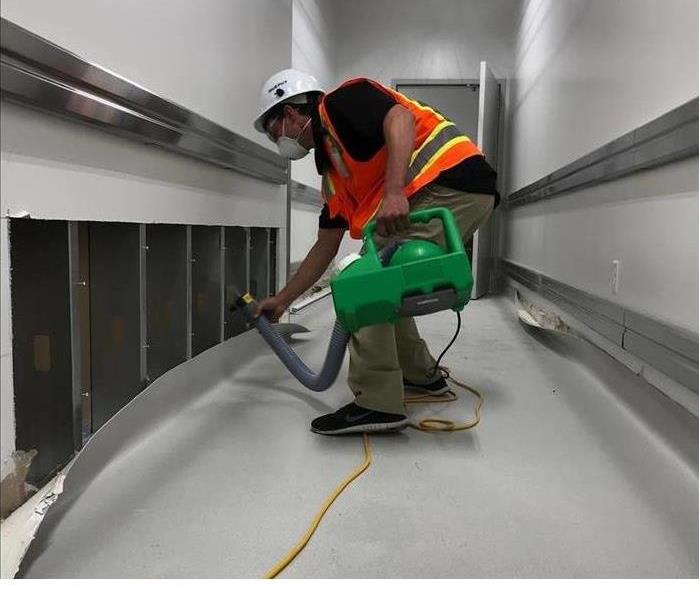Understanding the risk of occupational exposure to Covid -19
8/12/2020 (Permalink)
 Call SERVPRO of Woodland Hills to schedule a free consultation for COVID-19 cleaning and disinfecting. 818-882-4556
Call SERVPRO of Woodland Hills to schedule a free consultation for COVID-19 cleaning and disinfecting. 818-882-4556
To help employers understand the exposure risk of their workforce, the Occupational Safety and Health Administration (OSHA) issued guidance explaining how to categorize jobs and tasks based on an exposure risk pyramid. The OHSA model includes four levels: lower risk, medium risk, high risk, and very high risk.
Lower Risk (Caution):
- Workers in lower-risk roles have limited contact with the public and coworkers.
- Examples include employees who are working from home as well as office, manufacturing, or industrial workers who don't have frequent close contact (within six feet) with customers, coworkers, or the public. This category also includes healthcare workers who only provide telemedicine services and long-distance truck drivers.
Administrative Controls
¦ Monitor public health communications about COVID-19 recommendations and ensure that workers have access to that information. Frequently check the CDC COVID-19 website: www.cdc.gov/coronavirus/2019-ncov.
Medium Risk:
- Workers in medium-risk roles have frequent or contact with people who may be infected but who are not known to have or suspected of having COVID-19. For example, this category would include employees who may have frequent contact with travelers returning from international locations where COVID-19 is widespread, as well as work-related contact with the general public.
- Schools, densely populated work environments, and high-volume retail locations fall within this category.
Engineering Controls
¦ Install physical barriers, such as clear plastic sneeze guards, where feasible.
Administrative Controls
¦ Where appropriate, limit customers’ and the public’s access to the worksite or restrict access to only certain workplace areas.
¦ Consider strategies to minimize face-to-face contact (e.g., drive-through windows, phone-based communication, telework).
High Risk:
- Workers in high-risk roles have a high potential for exposure to people who are known to have or suspected of having COVID-19.
- This category includes healthcare workers and support staff who work with known or suspected COVID-19 patients, medical transport workers moving known or suspected COVID-19 patients in enclosed vehicles and mortuary workers involved in preparing bodies for burial or cremation of people known to have or suspected of having, COVID-19 at the time of death.
Administrative Controls
¦ If working in a healthcare facility, follow existing guidelines and facility standards of practice for identifying and isolating infected individuals and for protecting workers.
Very High Risk:
- Workers in these roles have a very high potential for exposure to known or suspected sources of COVID-19 during specific medical, postmortem, or laboratory procedures. Workers in this category include healthcare workers performing aerosol-generating procedures on known or suspected COVID-19 patients, healthcare or laboratory personnel collecting or handling specimens from known or suspected COVID-19 patients, and morgue workers performing autopsies, which generally involve aerosol-generating procedures, on the bodies of people who are known to have or are suspected of having COVID-19 at the time of death.
Administrative Controls
¦ If working in a healthcare facility, follow existing guidelines and facility standards of practice for identifying and isolating infected individuals and for protecting workers.
It's important to recognize that throughout the workday, duties and tasks may change, and workers may move from one exposure risk level to another.
Hazard and Risk Assessment
Employers should perform thorough hazard and risk assessments to identify if and when their workers may face an increased risk of exposure to any and all workplace hazards, including infectious communicable diseases such as COVID-19. Appropriate control measures for COVID-19 exposure including engineering controls, administrative controls, and safe work practices, and personal protective equipment (PPE) can then be put in place.
Exposure Beyond the Workplace
Occupational exposure is not the only factor that determines employees' risk of getting COVID-19. Conditions in the communities in which employees live and work also play a role in determining their exposure risk and activities outside work (such as travel) can put employees at risk as well.
Some people have a higher risk of developing serious illness if they contract COVID-19. People who are older than 65 or who have certain health conditions, such as heart disease, lung disease, liver disease, obesity, or diabetes, may be more likely to have a serious illness related to COVID-19, according to the Centers for Disease Control and Prevention (CDC).
Learn more about OSHA's guidance on recording COVID-19 cases on OSHA 300 injury and illness logs here.
Sources
OSHA COVID-19 Hazard Recognition


 24/7 Emergency Service
24/7 Emergency Service